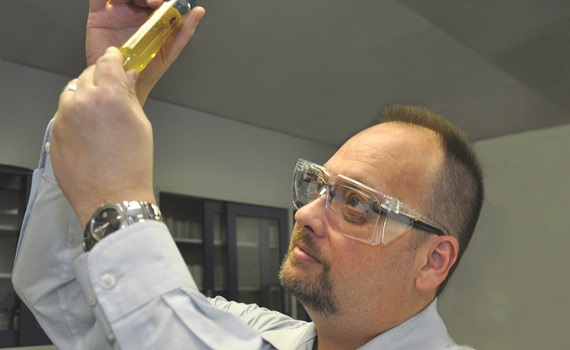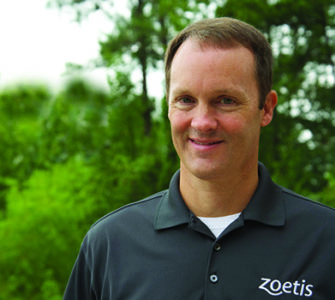Z-CAS helping feed mills, producers get the most from medicated feed additives
An interview with Marc Howerton, Customer Analytical Services Supervisor, Zoetis
Q: Zoetis Customer Analytical Services, or Z-CAS, appears to be one of the best kept secrets in the livestock and poultry industries.
MH: Well, yes and no. Last year, my team and I tested nearly 8,000 feed samples and ran about 6,500 assays for our medicated feed-additive customers — all for free, I might add — so a large segment of our customer base is actively using our services. We’ve seen considerable growth in demand over the past 3 years. Still, when you look at the actual tonnage of Zoetis feed medications sold worldwide, we know we’re only scratching the surface. We want to make more customers aware of what we do here.
Q: So, let’s back up a moment. What exactly is Z-CAS? And what services does it provide?
MH: Z-CAS is a feed-analysis laboratory based at our manufacturing plant in Chicago Heights, Illinois. We are certified GLP — that is, Good Laboratory Practices — and are routinely audited by FDA to ensure we meet their standards. That’s important because, now more than ever, regulatory agencies are demanding more transparency, accountability and compliance.
Feed companies and producers need to be diligent recordkeepers — not only to comply with the new regulations but also to document the contents of specific batches of feed for expected drug levels. That information also needs to be readily available. Our mission is to help customers stay compliant, work with them to prevent and correct problems and, perhaps most important, give them peace of mind.
Q: What types of problems?
MH: Let’s say the customer is using a medicated feed additive to treat a certain disease but the herd or flock is not responding as expected. We can analyze samples of that feed for expected drug levels. Too much or too little of a medication could have a serious impact on the health of the animals and also the producer’s bottom line.
We can also help troubleshoot new equipment and validate blenders. Customers also ask for our help reconciling their feed-medication inventory with their sales records. What’s causing those numbers to be out of sync? How do we fix the problem?
Q: And you keep records of all tests?
MH: Yes, we offer free data storage. But even more important, our customers now have easy access to all of their test results and data online through our new Feed Assay Portal, which includes trending tools and sampling tips. That can be especially helpful when trying to isolate problems over time. For example, what was the accuracy of our chlortetracycline usage over a 3-month period? By using the Feed Assay Portal or, if they prefer, contacting us directly, companies can monitor and detect statistical trends in the use of medicated feed additives. With growing pressure to use antibiotics more judiciously, that information becomes even more important.
Q: Have FDA’s new veterinary feed directive (VFD) rules had any impact on the demand for your services?
MH: Yes, we’re getting more calls for cleaning validations. To comply with the new VFD rules, commercial and farmer-owned feed mills need to be certain residues of VFD medications are below FDA‘s thresholds so they do not contaminate subsequent batches of feed. The Food Safety Modernization Act has also increased demand for our analytical services.
Q: Is all feed testing done in Chicago Heights?
MH: Thanks to a recent expansion to our laboratory, virtually all tests are done on the premises. That also means a faster turnaround time. We generally get results back to US customers within 5 to 7 days. Other labs can take up to 4 weeks.
Q: Most independent laboratories would charge up to $200 for analyzing one sample. You’re offering this service for free, often with a faster response time. What’s the catch?
MH: There isn’t one. It’s a free service to any customer using Zoetis medicated feed additives. Even the shipping is free if you use our envelopes. If it’s an urgent matter — for example, there’s a disease outbreak and the producer’s veterinarian needs the results quickly before making a recommendation — we don’t hit you for any rush charges. Other labs charge up to three times their normal rate for rushed samples.
Whether you buy a single bag or 50 metric tons, we consider you a customer. We can also get the Zoetis sales team and technical service veterinarians involved so they can help interpret results and make sound recommendations.
Q: If a high-volume customer submits a lot of samples — say, 300 samples valued at $200 each over the course of the year — that’s $60,000 in free laboratory services. That seems generous.
MH: It is generous when you crunch the numbers, but we prefer to focus on the value it brings to the industry. Our customers are among the best in the field — they strive for excellence in everything they do. If we can help prevent or solve feed or health problems and make their business healthier and more viable, everybody wins.
TOOLBOX, Issue 6
Toolbox is a series of interviews with veterinarians and other technical specialists about their experiences managing antimicrobials, vaccines and other tools for poultry health. It is produced by the editors of Poultry Health Today on behalf of the US Poultry Business of Zoetis.
POU-00073
Revised Nov 2020
Posted on November 30, 2020












